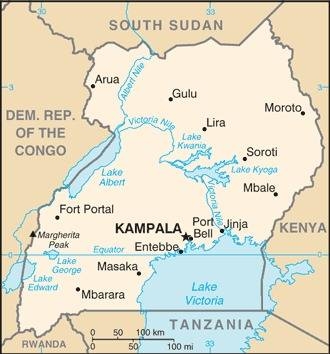228 Uganda

Six equal horizontal bands of black (top), yellow symbolizing sunshine and vitality, red symbolizing African brotherhood, black symbolizing the African people, yellow, and red. A white disk is superimposed at the center and depicts a grey crowned crane (the national symbol and military badge of Ugandan soldiers under the UK) facing the hoist side.
Flag courtesy of the CIA World Factbook

Map courtesy of the CIA World Factbook

Rhinoceros (Uganda Wildlife Education Center (zoo) near Kampala).
Photo courtesy of the CIA World Factbook
Government
According to Britannica, until 1967 Uganda was a quasi-federal polity that included 5 subregional monarchies, non-monarchical districts, and a central government. The republican constitution adopted in 1967 abolished the monarchies and assigned ultimate political power to an elected president. The president was to be aided by a ministerial cabinet drawn, in the British tradition, from among members of the unicameral National Assembly. In theory, the judiciary, legislature, and executive were to be autonomous, if coordinate, institutions of governance, but in reality the powers of the different branches of government have varied widely with each president. Under Idi Amin’s presidency (1971–79), representative institutions were abolished altogether, and, with the first of several military coups in 1985, the constitution was suspended.
Under the new constitution promulgated in October 1995, and since amended, the president is the head of state, government, and the armed forces and is assisted by a prime minister and cabinet. Legislative power is vested in the unicameral Parliament. Most members of Parliament are directly elected to 5-year terms; the remaining seats are reserved for one female representative from every district and representatives of specific groups, such as the army, youth, labour, and persons with disabilities. The constitution also recognizes the right of ethnic groups to pursue their own cultural practices. Uganda had a “no-party” political system until a 2005 referendum overwhelmingly supported a return to multiparty politics. The next year the country held its first multiparty elections since 1980.
Uganda is divided into districts. Each district is administered by an elected chairperson and a district council. Subdistrict administrative units are governed by a tiered structure of elected councils. Each council consists of elected members with the political and judicial power to manage local affairs.
The Supreme Court is the court of highest appeal; it also acts as a constitutional court. Below the Supreme Court is the Court of Appeal and the High Court. The Magistrates’ Courts were established in 1970 and decide criminal and civil matters. Islamic and customary law also exist in the country.
Uganda Civil Aviation Authority
Air transport services in Uganda started with the flying boats that landed at Port Bell, Luzira at the shores of Lake Victoria, to deliver mail. This was an extension of the Wilson Airways that itself started air operations in neighboring Kenya in 1929. In 1946, the Directorate of Civil Aviation (DCA) was formed, followed by the construction of the country’s airport at Entebbe in 1947. Entebbe International Airport was commissioned by princess Elizabeth of England in 1952. Following the establishment of the East African Community, civil aviation services were under a DCA and several government departments, leading to segmentation. The need to harmonize and efficiently run the services led to the establishment of the Uganda Civil Aviation Authority in 1991.
Airspace
SkyVector – Google Maps – ADS-B Exchange
ICAO countries publish an Aeronautical Information Publication (AIP). This document is divided into three parts: General (GEN), En Route (ENR) and Aerodromes (AD). ENR 1.4 details the types of airspace classes they chose to adopt from classes A through G.
Uganda AIP – requires login info
Drone Regulations
Advanced Air Mobility (AAM) Regulations & Policies
None found by the author.
However, should you, the reader, happen to stumble across something to the contrary, please email the author at FISHE5CA@erau.edu and you may be mentioned in the ACKNOWLEDGEMENTS section of this book by way of thanks for contributing to this free eBook!
Advanced Air Mobility (AAM) News
None found by the author.
However, should you, the reader, happen to stumble across something to the contrary, please email the author at FISHE5CA@erau.edu and you may be mentioned in the ACKNOWLEDGEMENTS section of this book by way of thanks for contributing to this free eBook!
Short Essay Questions
Scenario-Based Question
You have been hired by a Drone Startup Company. Your boss has immediately assigned this job to you.
They need you to prepare a one-page memo detailing the legalities of using a drone to film rhinos in Uganda, pictured above.
They need you to mention any national laws and local ordinances.
They specifically want to know what airspace (insert pictures) you will be operating in and whether or not you need an airspace authorization.
Does it matter whether or not you are a citizen of the country?
Lastly, there is a bonus for you if, as you scroll through this chapter, you find any typos or broken links!
Short Essay Questions
- What are the drone categories?
- How is registration addressed?
- How is remote ID addressed?
- What are the model aircraft rules?
- What are the commercial drone rules?
- Are there waivers or exemptions to the rules? If so, for what?
- Would you share a link to an interactive airspace map?
- How is BVLOS addressed?
- How can you fly drones at night?
- How can you fly drones over people?
- Where do you find drone NOTAMs?
- What are the rules for drone maintenance?
- What are the rules for an SMS program?
- What are some unique rules not mentioned above?
- What are the C-UAS rules?
- What are the AAM rules?

